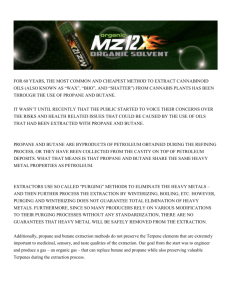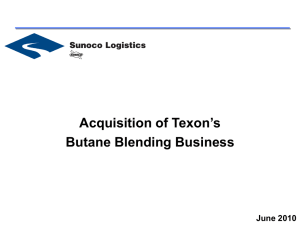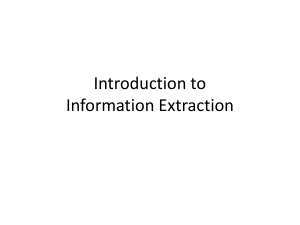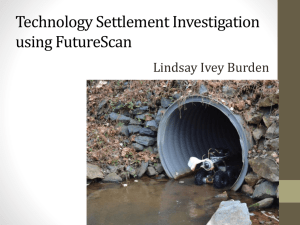Hash Oil Extraction Hazards
advertisement
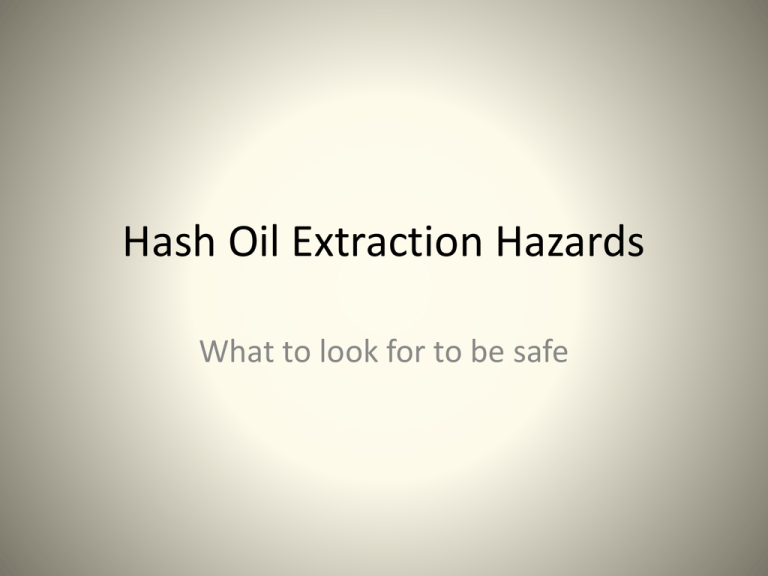
Hash Oil Extraction Hazards What to look for to be safe InfoGram 6-13: February 7, 2013 • • • • • • • Hash Oil Explosions Increasing Across U.S. Some explosions in residences and hotels around the country are being traced back to a process using butane to extract and concentrate compounds from marijuana. The extraction method appears to be more common on the west coast; reported fires and explosions have blown out windows, walls and caused numerous burn injuries. Depending on conditions at the scene, these explosions can be misidentified as pipe bombs (because of the extraction vessel used) or methamphetamine lab explosions. First responders, fire marshals, bomb squads and drug task force personnel should receive training to identify items used in hash oil extraction. Butane is necessary for the process and is available over-the-counter in 8-ounce cans. The extraction process uses one whole can and multiple cans will likely be at the scene. Butane is highly explosive, colorless, odorless and heavier than air and therefore can travel along the floor until it encounters an ignition source. The process also uses isopropyl or anhydrous alcohol, both flammable; extraction vessels; glass dishes; ether and coffee filters. The resulting substance is a thick yellow-orange oil called hash oil, honey oil, Butane Honey Oil (BHO) or dabs. Initial explosions can lead to secondary explosions and fires. In states with legalized use and availability of medical marijuana, these incidents appear to be increasing. In some of these states the legality of the actual production process is still in debate. (Source: Seattle Times) News Headlines Near fatal fire in hotel Apartment complex fire We have a “Winner!” What is Hash Oil? • Hash Oil, or oils from Marijuana plants have high levels of concentrated THC • The Oil is in liquid form and can be infused into products for easy and alternate consumption • Nickname “THC Honey, Marijuana Honey, Hash Oil Honey” and other various names How is Hash Oil used • After it is extracted it is commonly used in products to infuse THC for medical and now recreational use. The most common use of “Hash Oil” is combining it with sugar or sweeteners and flavorings and made into a hard candy Hash Oil Product hazards • With the new laws enacted in Washington State there is little to no oversight at this time in safeguards for products made with Hash Oil additives. Levels of THC or other chemicals bonded in the process (fertilizers, herbicides, or butane left over) are unregulated. • Candy is used and therefore is an elevated risk for children to misuse the products Sample of THC Hash Oil Candy 50 mg of THC per candy 10-25 mg of THC per candy Colorado company now in Washington (Tacoma) How is Hash Oil Extracted? • Oils in Marijuana are extracted through Butane being forced through the “Bud” and bonds with the oils and is extracted. • A small pipe (usually PVC) device is used with caps on both ends, a small hole in one end and several small holes in the other. This pipe resembles a “Pipe Bomb” Excerpts from “Concept 420” magazine • This method has its basis in a fascinating industrial extraction method known as Supercritical Fluid Extraction. It uses totally overthe-counter butane gas (8 oz can, camping supply store, ~US$4.50) as the extraction solvent, and requires nothing even remotely suspicious or difficult to purchase. The only other thing needed is about $2.00 worth of PVC pipe: a section 1.5 (one and a half) feet long and 1 & 3/4″ diameter (outer diameter I believe), and two end caps. Threaded PVC is not necessary. Items for Extraction Tools of the trade Extraction process Extraction Cont • In one of the PVC end caps, drill a single small hole in the center. This hole should be correctly sized to snugly receive the little outlet nozzle of your butane can. • In the other end cap, drill a group of 5 or 6 small holes clustered in the center (like a pepper shaker). Extraction Cont • Fill the pipe up with plant matter that has been pulverized into a coarse powder • Place the top end cap on the pipe. Again, push it on as securely as you can by hand. • Find a location outdoors with a decent breeze. You want these butane fumes to be quickly carried away. Seriously. Extraction cont • Turn the butane gas can upside down and dispense the gas into the pipe via the single top hole. A whole 8-oz can takes about 10-12 seconds to evacuate. Be brave, swift, and careful. A spark at this moment would spell disaster since you have basically created an incendiary explosive device that is leaking. Extraction Cont • Over approximately five to eight minutes, the butane extract will finish draining from the pipe to the receiving vessel. Maintain caution with the pipe, however, since there is a lot of residual butane still evaporating from within the pipe (notice the stream of fumes coming from the top hole). When it slows down to a drop every few seconds, you can tap on the top hole with your finger and it will help push the last of the liquid butane out (or one can gently blow into the top hole to do the same thing). Remember, NO SMOKING, unless you wish to immolate yourself in grand fashion. Final and most Hazardous process • At the end of the extraction process the butane needs to be evaporated off. This is safely done by letting it evaporate over time, but since THC Honey Oil makers appear impatient they either use a warm water bath, an alcohol wash, or better yet, use a propane torch to burn off the left over butane! Hash Oil Extraction Fire Tacoma House Fire • February 2nd 2013 at 22:57 hrs Tacoma Police and Fire Departments responded to 606 East 34th Street for a house fire. Upon arrival neighbors said they overheard a man yell “Oh Shit” and then heard “fireworks or lots of loud popping noises” and the fire erupted. No persons were found at the house when units arrived Located at Fire Scene • Officers reported “I would estimate the number of used Butane cans to be in the hundreds. I counted 11 boxes that contained 12 cans each. Those were the boxes that still had empty cans in them. There were numerous more broken down.” First In Fire Crews • E-11 arrived at 606 E 34th and found an aprox. 25’ x 30’ 2 story wood frame residential structure with fire venting on the C side, both floors. There was an enclosed porch type room w/ a shed roof on the C side that was fully involved with extension vertically into the shed roof and into the second floor of the structure. We made entry on the C side and attacked the fire. At no time did we encounter a closed exterior door. I do not know if the door was open or destroyed. After knocking down the fire in that area, we checked the rest of the first floor. We found a small propane torch sitting on a counter in the middle room of the first floor, which was venting gas. We turned it off. We opened the entry door for the crews on side A, and then went on to the second floor, which was heavily involved. The second floor appeared to be divided into a front, middle, and back room. The stairs came up into the back (C side) room. We knocked the fire down in that room, and had to stop briefly to wait a longer hoseline. While waiting, the middle and front rooms flashed over. We were able to partially extinguish that area, and when more hose became available, we advanced and knocked down the rest of the fire. My low air alarm began sounding, and we exited the building on side A. Fire Investigators Report (excerpts) • I also found hundreds of small butane cans. I found plastic PVC piping shaped in the form of a large pipe bomb that was packed with marijuana. • it is possible that the fire was caused by trying to extract hash oil out of cannabis with a propane torch with the use of the plastic pipe that I found in the area of the most significant burn. Hazards During Firefighting & Fire Investigations • Butane is odorless, colorless, and heavier than air and will seep into low lying areas. If the fire starts on an upper floor, crews need to be aware of possible gas on lower floors. • Butane canisters are pressurized and compressed highly flammable gas. Literally a hand sized fire grenade capable of severe injury and death. Most scenes have “hundreds” of cans! Hazards cont. • Since these fires can be at locations such as residential houses and for recreational uses, commercial uses or clandestine (and other illegal activities) there is no regulation or safeguards in place. Often times only after fire crews arrive and start firefighting operations it is discovered to be a Hash Oil Fire Secondary Hazards • Along with “Grow Operations” there is an inherent risk of protective and “security” improvised explosive devices. Since Hash Oil extraction tubes look like “Pipe Bombs” Public Safety personnel might take on the assumption that it is only an extraction tube but in reality it is a pipe bomb for the drug operators security Secondary Hazards cont. • If found in conjunction with a “Grow Op” be aware of improvised electrical systems (“Hot wires” in the fire scene hooked up to outside/stolen power sources) • Be aware it is possibly related to criminal activity and the victims/witnesses might be involved in a criminal enterprise and won’t cooperate or even pose an on scene threat Secondary Hazards cont. • Be aware that the off gassing and smoke venting from the fire is not only toxic but also contains unregulated THC (though it might sound funny, it is very dangerous and hazardous) as well as other carcinogens at higher levels due to materials involved (“Grow Ops” might have fertilizers, if a commercial candy operation is on fire the candy is highly concentrated with THC) Secondary Hazards cont. This photo was taken at the Tacoma Hash Oil fire on February 2nd 2013. Notice the cardboard bins are full of Hash Oil Candy and there are packages of the candy on the floor. If these bins were on fire the smoke could contain LETHAL doses of THC, even if you were outside assisting with ventilation or conducting a Fire Investigation and the products were still off gassing or the room still contained minor smoke. Final Thoughts & Reminders • If you locate items believed to be related to Hash Oil Extractions treat the scene as a hazardous materials or extreme hazardous environment (go by your local protocols) • Be aware of butane canisters that have become compromised due to heat and are still under pressure and treat them as explosives
